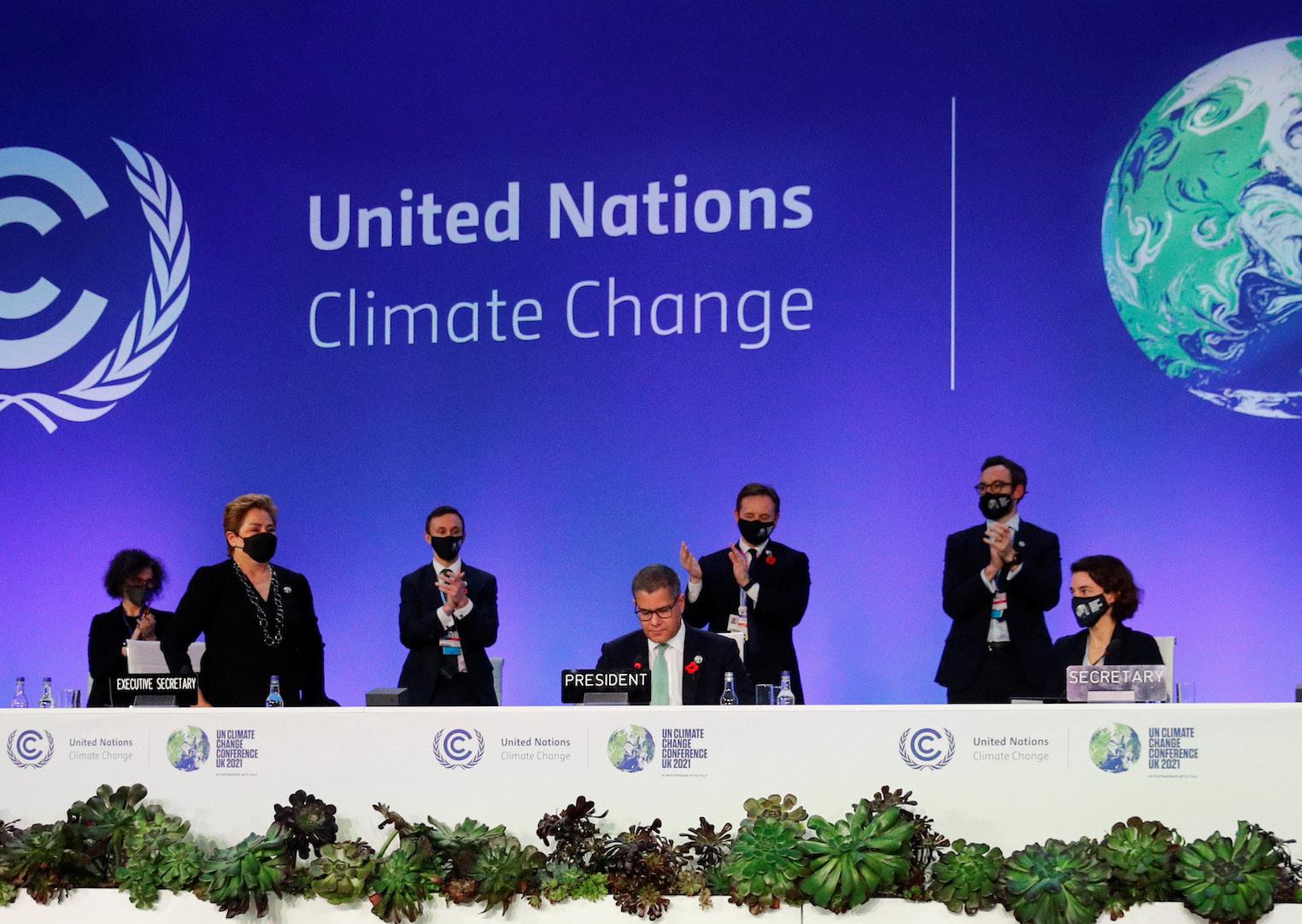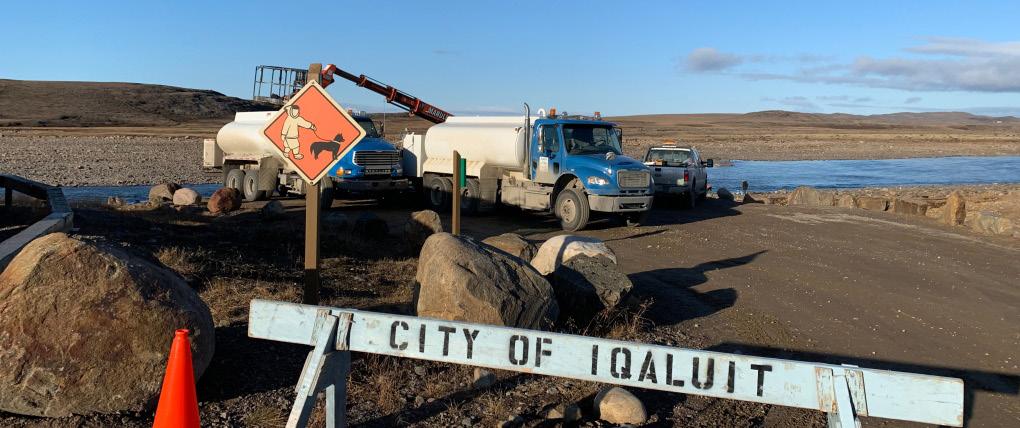
20 minute read
this issue
teams having a better chance at a higher pick. The Raptors were participants in the lottery for the first time since 2013, a testament to their prolonged success in the Masai Ujiri/Kyle Lowry era. In their first draft lottery in seven years, the Raptors got lucky. They nabbed the fourth pick behind Detroit, Houston, and Cleveland, with only a 33% chance of making it that high. With their pick, they selected Scottie Barnes, a forward from Florida State. The pick was not without controversy, as top draft picks often are. Many fans and league commentators believed that Jalen Suggs, a guard from Gonzaga, was the better pick. I was surprised by the Raptors’ pick of Barnes, but I’m happy to say I have been very impressed with his performance thus far. Scottie had an excellent showing at NBA Summer League in Las Vegas and through the first fifteen games this season has put up a 16PTS/8REB/3AST per-game stat line while playing 35 minutes a game and shooting 51% from the field. Plus, the stats do not take into account Scottie’s off-court presence. He is a natural leader with an excellent reputation and has embraced the city of Toronto, as well as the passionate Raptors fans that come with it. Fans were overjoyed to see Scottie touring the city, eating at iconic local restaurants, and even meeting up with Drake all before the season started. There is no easier way to endear yourself to Raptors fans than by actually wanting to play in Toronto. Aside from the Raptors’ new young star, the rest of the roster is showing promise. OG Anunoby is continuing to grow as a player and remains a defensive powerhouse; Gary Trent Jr. has proved that he is better than his former bench role in Portland suggested; fan favourite Canadians Khem Birch and Chris Boucher are back; young prospects Precious Achiuwa and Svi Mykhailiuk are getting solid minutes; Goran Dragić is doing what he can at age 35; and 2020 first-round pick Malachi Flynn is on a mission to prove himself as a serious game-time option for the team. There are many positives to work with, now it is about putting it all together and consistently winning games. Inconsistency is a typical characteristic of a rebuilding team, and this Raptors squad is no exception. There have been multiple highs and lows already. Perhaps the best example is the Raptors curb-stomping the Boston Celtics on October 22nd, beating them in their home arena by 32 and then losing to them by 16 less than three weeks later in the same building. Needless to say, the team is not yet performing to its full potential, and there is still quite a bit of practice and team-building needed before they really appear as a cohesive unit. Fortunately for fans, this will likely happen faster than they might think. Since the teardown was rather short compared to other rebuilds, the reconstruction should be similarly swift. The Raptors have retained all of their homegrown talent and have added even more development potential in Barnes. There may be a few more roster moves before this is all over and fans should expect some further turbulence in the near future. It may not look pretty right now, but with a talented team core, a world-class front office staff, and passionate fans once again filling the stands in Scotiabank Arena, the Raptors are poised to make a lot of progress this season. This should be exciting for everyone, regardless of their exact record.
The COP26 Rundown: What It Is, What Came Out of It, and What Canada Needs To Do Better
Advertisement
Kiran Basra SCIENCE
From October 31st to November 13th, 2021, the United Nations Framework Convention on Climate Change’s Conference of Parties was held in Glasgow, Scotland. 21,000 diplomats and activists from 200 countries, including 130 world leaders, met to discuss the problem of climate change and what countries would commit to fixing it. Marches took place all over the world—including 100,000 people in Glasgow itself—as prominent activists pushed for stricter measures. In 1992, 197 countries agreed to join the United Nations Framework Convention on Climate Change (UNFCCC), which includes meeting once a year for a UN forum called a Conference of Parties (COP). All countries are represented at COPs. This means that impoverished and developing countries, which tend to be disproportionately impacted by climate change, get an equal voice at the table. Delayed by a year because of the COVID-19 pandemic, COP26 was especially important because it marks 5 years since the Paris Agreement of 2015. The Paris Agreement specifies that all countries that signed must meet every five years (informally called a ‘ratchet’ year) with new, more ambitious goals to help fight climate change. These goals are called Nationally Determined Contributions (NDCs). The most important revision from COP26 seems surprisingly small: countries agreed to meet and revise their NDCs on a yearly basis, instead of every five years. Until global carbon emissions are reduced to safe levels, countries will have to come back every year and present a new NDC—which means laypeople and activists can put more pressure on these countries every year to present stronger measures against climate change. Speeding up the pace of climate negotiations is crucial since scientists say this next decade is essential to combating climate change. If we went five years with no change, it would be too late.
The second revision was to the goals of COP26 itself. This is the first agreement that explicitly mentioned cutting back fossil fuels. Additionally, when the Paris Agreement specifies its goal to keep the world’s temperature rise ‘well below 2°C’ (above pre-Industrial Revolution levels), it has now been revised to a more ambitious 1.5°C. It is necessary, though, since scientists say a rise in temperature above 1.5°C comes with far worse change: heatwaves, water shortages, crop failures, and ecosystem collapse. The world is already at 1.1°C above pre-Industrial Revolution levels, though, which means a big change needs to happen: the world’s carbon emissions must be down to 45% by 2030 and be at ‘net zero’ by 2050. The document was also going to commit to ‘phase out’ coal until India at the last moment insisted it be changed to ‘phase down’ coal. Coal is where most of India’s energy comes from, and the country threatened to pull out of the agreement unless the wording was changed. Alok Sharma, the leader of COP26 on behalf of the United Kingdom, had made phasing out coal his personal goal for the conference. However, he accepted this change out of fear the entire document would come apart since the conference was already one day over its scheduled time limit. While closing COP26, he personally apologized to smaller countries for this change in wording. Canada submitted a new NDC in July of 2021. Our goals have been changed to a 40–45% reduction of carbon emissions (compared to 2005 levels) by 2030, as opposed to the previously promised reduction of 30%. The new goal is to be at net zero carbon emissions by 2050. Wealthy nations (including Canada) have been encouraged to give aid in climate change funding to poorer countries, and Canada has pledged 5.3 billion USD. Canada’s policies don’t match up to its goals though; our carbon emissions have not decreased very much since 2015, and most of the money we pledged in aid in 2015 wasn’t spent. However, this summer the Canadian Net-Zero Emissions Accountability Act was passed, which makes implementing these policies a law. Even if the administration changes, Canada is still responsible to give an annual report on the current climate change targets. When these targets are missed, Canada’s failure will be publicly assessed, and the government will be held accountable. To implement these changes, Canada is using the Pan-Canadian Framework on Clean Growth and Climate, which includes 50 concrete actions and was developed in consultation with Indigenous peoples. It focuses on 4 key pillars: pricing carbon pollution, complementary actions to reduce emissions, adaptation and climate resilience, and clean technology, innovation, and jobs. Canada has also committed to conserving 25% of our marine spaces by 2025 and 30% by 2030. In conjunction with the United Nations, Canada has joined the Adaptation Action Coalition, partnering with Germany to rebuild trust in the UN’s international climate finance campaign, while also focusing on empowering women, girls, and Indigenous peoples to fight climate change. The UNFCCC was created in 1992 at the Rio Earth Summit and went into action in 1994. It was responsible for drafting the 1997 Kyoto Protocol, which was unpopular with developed countries because it didn’t ask countries with newly emerging economies to curb their emissions, and there were consequences for countries that didn’t meet their requirements. It was replaced in 2015 with the Paris Agreement, which required developing countries to curb their emissions (at a different pace), and no longer has reinforcement measures for countries that don’t meet their NDCs. The Paris Agreement is infamous among climate activists for not being strict enough, and countries tend to submit NDCs that aren’t calculated to reach the ultimate goals of the Paris Agreement. However, setting goals and reaching them are two very different things. Even with countries promising to cut their carbon emissions, they have been steadily rising since 2015 as policies go unimplemented. With worldwide current policies, by 2050 the world temperature will be 2.7°C above pre-Industrial Revolution levels, resulting in catastrophic damage. Even if every country met the goals they have set in their NDCs, the world would be at 2.1°C. To reach the Paris Agreement, Canada would have to cut its carbon emissions by 54% by 2030. Since Canada is a comparatively rich country with a comparatively small population, our more important task is helping developing countries do the same. At COP26, Simon Kofe, the foreign minister for Tuvalu, gave a speech standing knee-deep in water to illustrate that with a rise in temperature of more than 1.5°C, his entire country would be underwater. World leaders need to commit to change, and quickly. While turning our lights off and taking public transit is important, the average person does not contribute that much to climate change; 100 companies are responsible for 71% of global greenhouse gas emissions. What we can do is pressure our government to implement the policies it has promised to implement and to put pressure on those companies for us. In 11 months, COP27 provides an opportunity to make our voices heard again. We must hope that our governments listen.

COP26: Nothing but Empty Words, No Action, and Accessibility
Catherine Dume POLITICS
As every journalist, blogger, and influencer talks about COP26 and its new deals for climate change, one of the biggest voices is Swedish activist Greta Thunberg. Thunberg critiques the frivolousness of these conferences, stating that they are nothing but “blah, blah, blah”—empty words with no actions. While some say the same about the 18-year-old, who only critiques leadership without offering solutions in return, her words hold weight, especially regarding one story that seemed to be overshadowed by the drama of the apocalyptic future that we may be heading towards. This story is about how the United Nations (UN), the champion of human rights, fails to be accessible. Israeli minister and wheelchair user, Karine Elharrar, tweeted, “Sad the UN does not provide accessibility to its events.” Later, Elharrar informed journalists that despite informing organizers of her needs in advance, the shuttle bus she was offered was not wheelchair accessible. Thus, she had to be deferred to another vehicle that was not allowed to enter the compound. This incident is not the only case of inaccessibility that unfortunately occurred during the conference. According to Disability News Service (DNS), there was a failure to provide British Sign language interpreters and captions for the broadcasts at COP26. Another incident regarding the closure of the accessibility entrance was when Jason Boberg from Sustained Ability Disability and Climate Network said that not only was he unable to join the conference, but the closure had also led to the injury of some of his colleagues. Boberg and others had to wait until the afternoon to enter when the accessibility entrance was opened, which caused them to miss some of the events. The significance of these incidents reveals that the UN, which published the Convention on the Rights of Persons with Disabilities back in 2008, may not follow its own policies, essentially rendering that document, and future ones, nothing but empty promises to individuals with accessibility needs around the world. The fact that the UN’s lack of accessibility impacted influential people who attended COP26 only highlights that society forgets even the most important people in the room when it comes to accessibility. As Greta Thunberg eloquently put it, world leaders and organizations should be held accountable not by their words but by their actions. After all, actions speak louder than words. Obviously society needs to be more accountable, but it is the how that adds nuance to those words. We need more than policies, rules, and legislation that speaks about equality and equity. We need concrete, detailed plans to implement policies that ensure every wheelchair user is able to get around the city and enter any building with ease. It may require the redesigning of modern and old architecture to do so, but if it grants accessibility, just do it. I know that when we talk about accessibility everyone gets tight-lipped and considers the cost of it all, but I assure you it is worth every penny. Not only does an accessible city do wonders for those who need it, but it is also designed to make everyone’s life easier. With these incidents at the UN and the issue of the plastic straw ban, one would think that accessibility and keeping our Earth green are incompatible. It is only when society forgets about the needs of people with disabilities when crafting their green policies and products that they are inaccessible. It is possible to save the planet and the humans who live within it; it just requires more intentional consideration and collaboration.

“DO NOT CONSUME”: The Terrifying Tale of a River Turned Toxic — The Water Shortage in Inqaluit
Mackenzie Da Silva POLITICS
Towards the end of October, Iqaluit, Nunavut announced that the city was in a state of emergency due to fuel found in water samples. Not only were residents unable to drink tap water since the contamination was discovered, but daily water uses ranging from hand washing to equipment sterilization at hospitals were also negatively impacted. It would be heedless to think of Iqaluit’s water crisis as independent from Canada’s long history of environmental racism. Environmental racism can be understood as policies and actions regarding issues that target racialized communities and put them in danger. In Iqaluit’s case, it is where toxic waste is dumped. In Canada, environmental racism disproportionately affects Indigenous communities and is a deliberate act of racism, as exemplified by the Coastal Gaslink Pipeline project, where a pipeline is being installed throughout British Columbia to transport gas. Communities such as the Wet’suwet’en have been protesting against this pipeline’s construction. Installing the pipeline so close to Indigenous communities could be hazardous to their health as gas is being transported past them every day. The mere construction of the pipeline also encroaches on their land rights. Despite these concerns, construction Continued on page 7...
on the pipeline was not halted. If you visit the Coastal GasLink website, you will be greeted with the quote, “Health and safety is our number one value.” It is important to note that while the world has slowed down due to the COVID-19 pandemic, work on building the pipeline continues. This is just one example of environmental racism in Canada. Environmental racism is so prominent in Canada that there is even an Ontario region nicknamed “Chemical Valley” near Sarnia, which houses 40% of the country’s chemical industry. A 2017 study by the Environmental Commissioner of Ontario found that the pollution from Chemical Valley disproportionately affects the Aamjiwnaang community. While these examples are fairly recent, environmental racism in Canada is by no means a recent issue and has been prevalent since the first colonial settlements. The present situation of environmental racism in Canada brings us back to the water shortage in Iqaluit. Since Iqaluit’s water has been declared contaminated, the Canadian Armed Forces have arrived on site to deliver clean drinking water. They have also set up equipment for what CTV News terms ‘reverse osmosis water purification’. The challenge, however, is that Canada’s water purification units have been previously used in warmer climates. Running these units in Iqaluit in late October will prove a new challenge, one that Canada’s water purification team says they are up for. Additionally, according to Nunavut News, a water monitoring system has been installed through which residents can now access filtered water for daily use. The monitoring system is said to provide real-time detection of concentrations of different hydrocarbons in the water, notifying the water treatment plant operators when necessary. Quick action is necessary for a crisis such as Iqaluit’s water shortage, but the question still lingers: has the damage already been done? CTV News reports that Nunavut’s chief public health officer, Dr. Michael Patterson, has told residents that the health risks for those who consumed the contaminated tap water are very low. Nunavut News confirms that the government of Nunavut will publicly present the data they have collected thus far at an unspecified future date. The concern continues to persist however as Patterson updates residents that they may still smell fuel in their water, even though the city has dealt with the contaminated tank. Nunavut News reports that the “do not consume” order still remains, so using tap water to drink or cook with is unsafe. However, the water may now be used for laundry, cleaning, bathing, and dish washing. According to Nunavut News, the current hydrocarbon levels detected in Iqaluit’s tap water do not pose long-term health risks. The repercussions of Iqaluit’s only hospital being shut down due to the inability to properly wash hands and sterilize equipment are also being felt. As The Globe and Mail reports, the mother of resident Janet Pitsiulaaq Brewster was sent on a flight to Ottawa after requiring an emergency procedure that would have otherwise been available at Iqaluit’s Qikiqtani General Hospital. While the damage has been done and temporary solutions have been provided, more is required from the Canadian government to cover the cost of what needs to be repaired. NDP leader, Jagmeet Singh, has called on the federal government to cover the $180 million required to permanently solve Iqaluit’s water problem. Singh pointed out that for years, Nunavut has received a lack of funding from the federal government, and their current water crisis is a result of this negligence. After careful investigation, the city of Iqaluit has been able to trace its water contamination back to an underground tank that had not been upgraded since 1962. Reports have indicated that residents could have begun smelling fuel in their drinking water as early as October 2nd. According to CTV News, Singh urged the federal government to imagine how they would have immediately stepped in and fixed the issue, no matter the cost, if the water had been contaminated in Vancouver or Toronto. Singh suggested the government apply the same urgency and care to Iqaluit. Due to the long history of environmental racism in Canada, there is no quick fix to the issue. However, Ecojustice.ca describes a few initiatives on their website that could help position the country to better support its Indigenous communities and prevent more crises from occurring in the future. These include calling on the federal government to update the Canadian Environmental Protection Act, making it more suitable to today’s modern age, as well as passing Bill C-230, which is in the consideration stage as of June 2021 according to the Canadian Parliament website. Passing Bill C-230 would mean that the Minister of Environment and Climate Change in Canada would be required to plan and develop a national strategy to remedy the harms caused by environmental racism. The residents of Iqaluit have not been able to drink tap water for a month. I encourage us as citizens of Toronto at the University of Toronto to think about what Singh proposed: how would the same issue be handled if it occurred here in our major city? I encourage readers to explore the internet for sources, such as Ecojustice.ca, to learn what we can do to educate ourselves and listen to the communities affected by environmental racism. What we can do to work towards the end goal of dismantling the injustices ever-present in Canada.

————— winter break blues —————
Mayumi Ramos PLAYLIST
You know that weird, liminal period of time during winter break, after the holidays have passed, but before school starts again? It’s 1:38 AM and you’re languishing in your room, looking outside at your suburban neighbourhood. The winter sky refuses to turn pitch-black—it’s this eerie, foggy, murky grey-blue colour—and the houses on your street still have their Christmas lights up, but they haven’t turned them on for days. You feel a strange sadness, but you feel guilty about it because damn it, this was supposed to be the most wonderful time of the year! And yet, all you can bring yourself to do is put on the saddest playlist you have and lie facedown on your bed, head buried in the pillow. Well, this is that playlist. It starts off with Julia Jacklin lyrically painting a melancholic picture of a depressing family party (so much for the holiday spirit, am I right?), then transitions into Phoebe Bridgers somberly—yet tenderly—reflecting on Christmas while convincing herself that the new year will be better. The next seven songs are soft, subdued, and understated. Then, it suddenly escalates with the last three songs, all of which are dreamlike, transcendent, and almost otherworldly; crescendoing with the last two verses of “Teenage Blue”.

My favourite lyric (“Did you ever see a night so long / When time goes crawling by / The moon just went behind the cloud / I’m so lonesome I could cry”) perfectly encapsulates the mood and atmosphere that this playlist creates. For 45 minutes and 3 seconds, it seems like you’re the only one who exists in the world, and you’re conflicted about whether you should revel in that feeling or try to get rid of it, because, God, you’re just so lonely. Hopefully, you can take some comfort (or, more realistically, experience a catharsis) through these songs.
TRACKLIST

1. baby jesus is nobody’s baby now — Julia Jacklin

5. Pale Blue Eyes — The Velvet Underground
2. If We Make It Through December — Phoebe Bridgers


6. Reflections After Jane — The Clientele 3. cardigan (cabin in candlelight version) — Taylor Swift 4. I’m So Lonesome I Could Cry — Yo La Tengo




7. Baby Blue — King Krule 8. Some things Cosmic — Angel Olsen








